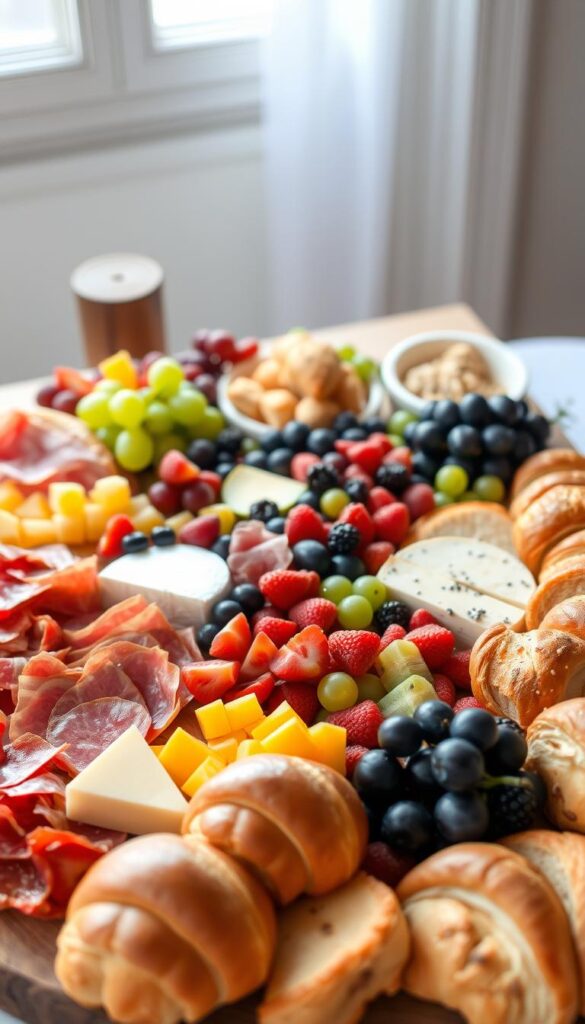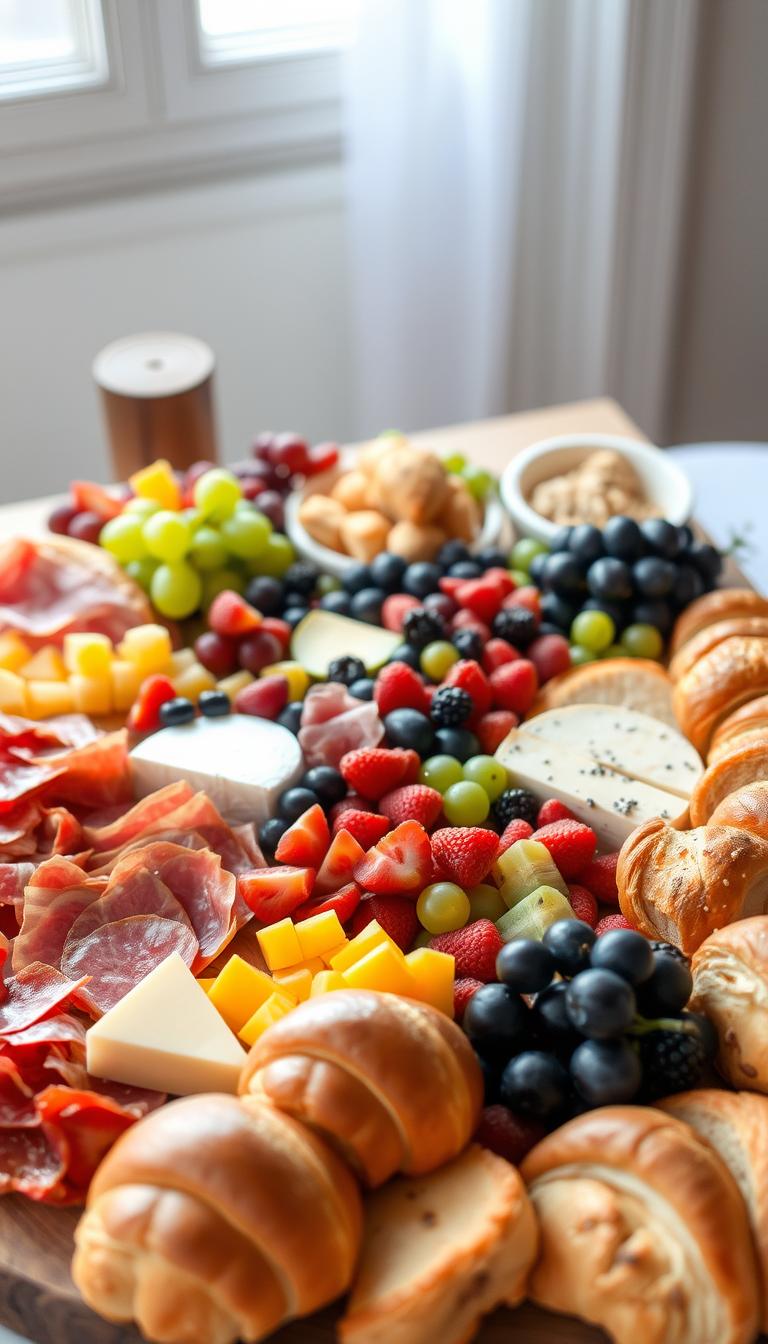Imagine gathering your closest friends and family on a lazy Sunday morning, the aroma of freshly brewed coffee wafting through the air, mingling with the crisp scent of fresh bread and the sweet tang of ripe fruits. A brunch charcuterie board is not just a meal; it’s a culinary tapestry that weaves together diverse flavors and textures, creating a communal experience that is as much about connection as it is about indulgence. This board is a perfect balance of savory and sweet, offering something for every palate, inviting everyone to linger and savor the morning.
The Origins and Evolution of Charcuterie
Charcuterie, a word that may sound as if it dances off a Parisian tongue, has its roots deep in French culinary tradition. Originally, charcuterie was the domain of the charcutier, the meat specialist who crafted preserved meats and sausages long before refrigeration was a reality. These artisans transformed humble cuts of pork into luxurious delicacies, a practice that dates back to the Roman Empire. Over time, the concept of charcuterie expanded beyond meats to incorporate a broader array of foods that celebrate the art of preservation and presentation.
In modern cuisine, charcuterie boards have become an emblem of sophisticated yet relaxed dining. They bring together cured meats, cheeses, fruits, nuts, and various accompaniments into a single, elegant display. The brunch charcuterie board is a delightful evolution of this concept, adapting the traditional elements for a morning gathering. It retains the essence of charcuterie while infusing it with brunch staples like pastries, spreads, and fresh produce.
The Art of Assembling a Brunch Charcuterie Board
Creating a brunch charcuterie board is akin to painting on a blank canvas, where each ingredient is a brushstroke contributing to the overall masterpiece. The beauty of this board lies in its versatility and the opportunity it presents for creativity. Start with a selection of cheeses—perhaps a creamy Brie, a sharp aged cheddar, and a tangy goat cheese. Each cheese offers a unique texture and flavor profile, providing depth and contrast.
Next, consider the meats. While traditional charcuterie might focus on heavier, cured meats, for a brunch setting, you may opt for lighter options such as thinly sliced smoked salmon or prosciutto. These choices not only complement the cheeses but also add an element of sophistication.
Fruits and vegetables are the jewels of your board, adding bursts of color and freshness. Seasonal fruits like berries, figs, and stone fruits bring sweetness, while crisp vegetables such as radishes or cherry tomatoes add a refreshing crunch. These elements not only elevate the visual appeal but also provide a counterbalance to the richness of the cheeses and meats.
Unique Ingredients and Flavor Profiles
One of the joys of a brunch charcuterie board is its ability to surprise and delight with unexpected flavors and textures. Consider incorporating artisanal jams or honeycomb, which pair beautifully with cheeses and meats, adding sweetness and complexity. Lightly toasted nuts and seeds provide a delightful crunch and a nutty undertone that enhances the overall taste.
Remember the bread and crackers, the foundational elements that tie the board together. A variety of options—such as croissants, baguette slices, and seeded crackers—offer different textures and flavors, allowing guests to create their own perfect bites.
Techniques for a Memorable Presentation
The presentation of a brunch charcuterie board is as important as its composition. Begin by selecting a large, flat surface—a wooden board or a marble slab works wonderfully. Arrange the cheeses and meats first, creating focal points on the board. Then, fill in the spaces with fruits, vegetables, and other accompaniments. Use small bowls or ramekins for items like olives, nuts, or spreads to keep the board tidy and organized.
Vary the shapes and sizes of the ingredients to add visual interest. Fold meats into delicate rosettes, slice fruits into thin wedges, and scatter nuts or edible flowers for a touch of whimsy. The goal is to create a feast for the eyes as well as the palate, inviting guests to explore and interact with the board.
In essence, a brunch charcuterie board is more than a meal; it’s a celebration of flavors, an invitation to gather, and a testament to the joy of sharing food with loved ones. So, roll up your sleeves, unleash your creativity, and craft a board that will not only satisfy hunger but also warm the heart.

Brunch Charcuterie Board
Description
This brunch charcuterie board is a feast for the eyes and palate, combining cheeses, fruits, pastries, and meats for a perfect balance of flavors and textures.
Ingredients
Fruits and Berries
Cheeses
Meats
Breads and Crackers
Condiments and Extras
Instructions
Preparing the Board
-
Select the Right Board
Choose a large wooden or marble board as your canvas. It should be big enough to hold an assortment of brunch items comfortably.Wooden boards add a rustic charm, while marble keeps things chic and cool. -
Gather Your Ingredients
Lay out all your ingredients and serving tools before starting. This includes cheeses, meats, fruits, breads, and spreads.Having everything on hand makes assembly smooth and stress-free.
Assembling the Charcuterie Board
-
Arrange the Cheeses
Start by placing the cheeses around the board, spacing them out to create balance. Use a mix of hard, soft, and spreadable cheeses.Let the cheeses come to room temperature for the best flavor. -
Add the Meats
Fold and fan out slices of cured meats like prosciutto and salami between the cheeses, creating visual interest and easy access.Consider using a variety of textures and flavors for depth. -
Incorporate Fresh Fruits
Nestle clusters of grapes, slices of apples, and berries around the board to add pops of color and sweetness.Keep fruits bite-sized to encourage easy snacking. -
Include Breads and Crackers
Position an array of sliced baguette, crackers, and breadsticks in the empty spaces. These act as vehicles for your toppings.Offer a gluten-free option to accommodate dietary needs. -
Add Jams and Spreads
Place small bowls or ramekins filled with fig jam, honey, or mustard around the board. These add a touch of sweetness or tang.Don't forget a tiny spoon or spreader for each bowl. -
Garnish and Final Touches
Finish with a scattering of nuts, fresh herbs, or edible flowers for an extra flourish.These garnishes elevate the board and introduce delightful aromatic elements.
Note
For a balanced brunch charcuterie board, consider including a variety of textures and flavors. Incorporate both savory and sweet elements. Begin with a selection of cured meats such as prosciutto, salami, and soppressata. To complement these, add an array of cheeses; soft options like brie or camembert, and harder varieties like aged cheddar or gouda work well. Fresh fruits such as berries, grapes, and slices of apple or pear add a refreshing contrast and a hint of sweetness. Dried fruits like apricots and figs can also add a chewy texture and rich taste. For crunch, include a selection of nuts; almonds, walnuts, or pecans are ideal. Remember to add some spreads or dips for variety—honey, fig jam, and grainy mustard are excellent choices that pair beautifully with both meats and cheeses. Include some fresh bread, like baguette slices, and a selection of crackers to serve as vessels for the spreads and cheeses. To elevate the visual appeal, arrange the items in a way that's easy to navigate, starting with the larger items like cheeses and meats, and then filling in with smaller items like fruits and nuts. Garnish with fresh herbs such as rosemary or thyme for a pop of color and aroma. Consider dietary preferences or restrictions, offering gluten-free crackers or plant-based cheese options if needed. The board should be a feast for the eyes as well as the palate, so take your time with the presentation.

